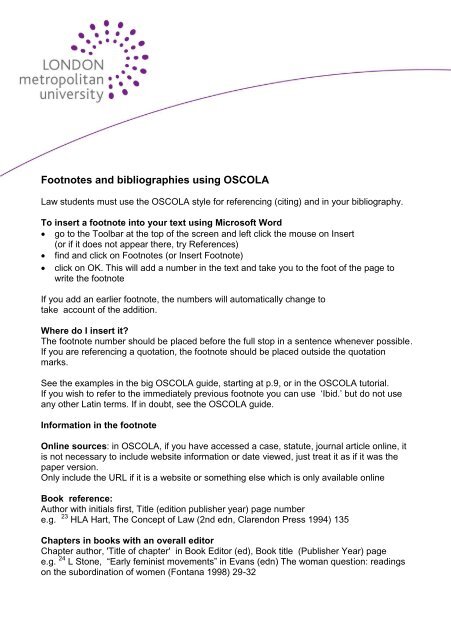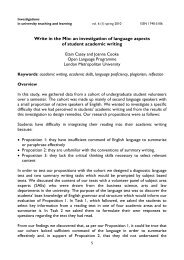Footnotes and bibliographies using OSCOLA - Metranet
Footnotes and bibliographies using OSCOLA - Metranet
Footnotes and bibliographies using OSCOLA - Metranet
You also want an ePaper? Increase the reach of your titles
YUMPU automatically turns print PDFs into web optimized ePapers that Google loves.
<strong>Footnotes</strong> <strong>and</strong> <strong>bibliographies</strong> <strong>using</strong> <strong>OSCOLA</strong><br />
Law students must use the <strong>OSCOLA</strong> style for referencing (citing) <strong>and</strong> in your bibliography.<br />
To insert a footnote into your text <strong>using</strong> Microsoft Word<br />
go to the Toolbar at the top of the screen <strong>and</strong> left click the mouse on Insert<br />
(or if it does not appear there, try References)<br />
find <strong>and</strong> click on <strong>Footnotes</strong> (or Insert Footnote)<br />
click on OK. This will add a number in the text <strong>and</strong> take you to the foot of the page to<br />
write the footnote<br />
If you add an earlier footnote, the numbers will automatically change to<br />
take account of the addition.<br />
Where do I insert it<br />
The footnote number should be placed before the full stop in a sentence whenever possible.<br />
If you are referencing a quotation, the footnote should be placed outside the quotation<br />
marks.<br />
See the examples in the big <strong>OSCOLA</strong> guide, starting at p.9, or in the <strong>OSCOLA</strong> tutorial.<br />
If you wish to refer to the immediately previous footnote you can use ‘Ibid.’ but do not use<br />
any other Latin terms. If in doubt, see the <strong>OSCOLA</strong> guide.<br />
Information in the footnote<br />
Online sources: in <strong>OSCOLA</strong>, if you have accessed a case, statute, journal article online, it<br />
is not necessary to include website information or date viewed, just treat it as if it was the<br />
paper version.<br />
Only include the URL if it is a website or something else which is only available online<br />
Book reference:<br />
Author with initials first, Title (edition publisher year) page number<br />
e.g. 23 HLA Hart, The Concept of Law (2nd edn, Clarendon Press 1994) 135<br />
Chapters in books with an overall editor<br />
Chapter author, 'Title of chapter' in Book Editor (ed), Book title (Publisher Year) page<br />
e.g. 24 L Stone, “Early feminist movements” in Evans (edn) The woman question: readings<br />
on the subordination of women (Fontana 1998) 29-32
Journal reference:<br />
Author with initials first, “Article title” (year) page abbreviated journal title (you can find<br />
these in the Cardiff Index of Legal Abbreviations<br />
e.g. 25 FH Newark, ‘The Boundaries of Nuisance’ (1949) 65 LQR<br />
Case reference:<br />
Names of the parties in the text then in the footnote the case citation<br />
e.g. 3 Phipps v Boardman [1967] is 32 AC 46 (HL)<br />
If you quote from a case or mention a particular point, give the exact page number so<br />
anyone who wants to read further can go straight to it.<br />
Legislation reference<br />
Title of statute, year <strong>and</strong> chapter number. The relevant Section/sub-section etc. should then<br />
be cited.<br />
e.g. 4 Human Rights Act 1998, s 2.<br />
Internet references<br />
Author, 'Web page title' (Website, Full Date) accessed Date<br />
e.g. 5 R Moorhead, 'Solicitors First' (Lawyer Watch, 25 March 2011)<br />
accessed 13 April 2011<br />
In the Bibliography<br />
Bibliographies should include cases, statutes, books, journal articles, reports <strong>and</strong> any other<br />
written sources which you have used in your research, whether you have quoted directly<br />
from them or referred to them by name in your essay/ dissertation/ project.<br />
There can be no prescribed number of references, but the best <strong>bibliographies</strong> use a variety<br />
of sources, include all relevant <strong>and</strong> accessible material <strong>and</strong> are set out in accordance with<br />
the correct style.<br />
From the outset of your literature search you should make full records of every publication,<br />
including Internet addresses. This may appear time consuming but it will ultimately save<br />
you much time <strong>and</strong> strife. You can produce a basic bibliography by copying <strong>and</strong> pasting all<br />
your footnotes onto a separate page, then moving the author initial(s) to after the surname.<br />
e.g. Fisher E, Risk Regulation <strong>and</strong> Administrative Constitutionalism (Hart Publishing 2007)<br />
Now add any other books or sources you may have referred to but not specifically cited,<br />
<strong>and</strong> divide into categories such as books, articles, statutes, cases <strong>and</strong> other sources. Within<br />
each category you should list the references alphabetically by author or, failing that, title.<br />
Sorting your references<br />
You can use Word to sort each section. It is easier to do it in section rather than the whole<br />
list at once<br />
• Select the text in each section.<br />
• On the Home tab, in the Paragraph group, click Sort.<br />
• In the Sort Text dialog box, under Sort by, click Paragraphs <strong>and</strong> Text, <strong>and</strong> then click<br />
Ascending
If you are citing more than one item by the same author, list the items in each category<br />
chronologically (in year order). After the reference to the first item, you can replace the<br />
author's name with two dashes (--):<br />
e.g. Hart HLA, Law, Liberty <strong>and</strong> Morality (OUP 1963)<br />
--Punishment <strong>and</strong> Responsibility (OUP 1968)<br />
If you cannot find an Author, use the dashes (--) instead (rather than Anon) <strong>and</strong> place them<br />
at the beginning of the section<br />
Books<br />
References for books need to contain<br />
Author followed by initial(s), Title (Publisher date)<br />
e.g. Choudhry S <strong>and</strong> Herring J, European Human Rights <strong>and</strong> Family Law (OUP 2010)<br />
Chapter from edited book<br />
Author followed by initial or name, ‘title’ in editor (ed), book title (additional information,|<br />
publisher year)<br />
e.g. John Cartwright, ‘The Fiction of the “Reasonable Man”’ in AG Castermans <strong>and</strong> others<br />
(eds), Ex Libris Hans Nieuwenhuis (Kluwer 2009)<br />
Journal Articles<br />
Author followed by name or initial, “article title” (year) volume number official journal<br />
abbreviation page<br />
e.g. Moorhead R, 'An American Future Contingency Fees, Claims Explosions <strong>and</strong><br />
Evidence from Employment Tribunals' (2010) 73 MLR 752<br />
N.B. Remember you can find the official abbreviations in the Cardiff Index of Legal<br />
Abbreviations<br />
For Government publications, reports, news media, websites, etc see examples given in<br />
the big <strong>OSCOLA</strong> guide.<br />
C.Smart<br />
January 2014



